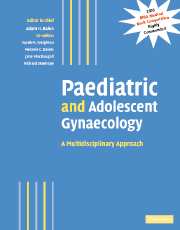Book contents
- Frontmatter
- Contents
- Contributors
- Preface
- Part I Normal development
- 1 Embryology of the female genital tract
- 2 Molecular genetics of gonad development
- 3 Gonadotrophin receptors
- 4 Normal childhood, puberty and adolescence
- 5 Control of the menstrual cycle and fertility
- 6 Nutrition and reproductive function
- 7 Normal bladder control and function
- 8 Development of sexuality: psychological perspectives
- Part II Management of developmental abnormalities of the genital tract
- Part III Management of specific disorders
- Index
- Plate section
- References
7 - Normal bladder control and function
from Part I - Normal development
Published online by Cambridge University Press: 04 May 2010
- Frontmatter
- Contents
- Contributors
- Preface
- Part I Normal development
- 1 Embryology of the female genital tract
- 2 Molecular genetics of gonad development
- 3 Gonadotrophin receptors
- 4 Normal childhood, puberty and adolescence
- 5 Control of the menstrual cycle and fertility
- 6 Nutrition and reproductive function
- 7 Normal bladder control and function
- 8 Development of sexuality: psychological perspectives
- Part II Management of developmental abnormalities of the genital tract
- Part III Management of specific disorders
- Index
- Plate section
- References
Summary
Introduction
The bladder is an amazing organ with an ability to increase its volume dramatically with little increase in its internal pressure whilst maintaining a securely closed outlet. This enables the bladder to collect urine excreted by the kidneys and store it securely within the body. When the time is appropriate, contraction of the bladder muscular wall causes a rapid rise in its internal pressure and, together with simultaneous relaxation of its outlet, allows urine to be expelled via the urethra. The bladder empties to completion before its outlet closes and its walls relax again to start the next filling cycle.
We start this chapter with a discussion of the anatomy, innervation and control mechanisms of the normal bladder, followed with the evolution of its function from the fetus to the continent adult, the means by which we assess its function and, finally, what is currently known about the effect of sex steroids, the menstrual cycle and pregnancy on the female bladder.
Anatomy
The bladder is an abdominal organ in the fetus and infant that descends as the pelvis deepens towards puberty to become a truly pelvic organ in the mature female (Fig. 7.1). At its apex is the fibrous remnant of the urachus, which ascends in the midline to the umbilicus. Its posterosuperior surface is covered by peritoneum, which is continuous with that of the anterior abdominal wall. As it fills with urine, the bladder rises out of the pelvis between the anterior abdominal wall and its covering peritoneum.
- Type
- Chapter
- Information
- Paediatric and Adolescent GynaecologyA Multidisciplinary Approach, pp. 65 - 76Publisher: Cambridge University PressPrint publication year: 2004
References
- 1
- Cited by



